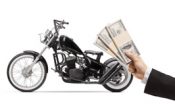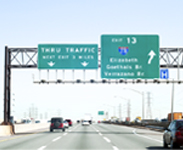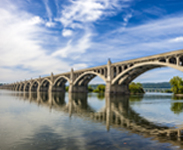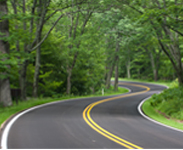
Home > Motorcycle Community > Tips for Motorcycle Riders > How to Ride Safely on a Highway
How to Ride Safely on a Highway
As a new motorcycle rider, you will face many challenges while out on the road. One of the most intimidating for a first time motorcycle rider is heading out on the highway. This is understandable, as you can feel exposed, there are multiple lanes, and high speed limits. In reality, riding on the highway can be safer than navigating city streets. The traffic travels in the same direction, there are limited entrances and exits, there is no cross traffic, and people generally travel at similar speeds. These motorcycle tips will show you how to ride a motorcycle safely while on the highway.
Choose the Time of Day
Riding during the day is the safest time to ride your motorcycle on the highway. If you have the option, choose daytime riding over nighttime. Staying safe includes being visible while on the road. This is more challenging at night.
Consider the time of day when riding on the highway. Rush hour traffic during the morning and in the afternoon are the worst times of the day to ride on the highway. Traffic during these times is at its heaviest. You may also have to deal with an increased number of distracted or stressed drivers.
Consider the Weather
If you have the option, wait to ride on the highway until it is bright and sunny outside. Better weather makes for safer highway riding conditions. Wait until the fog has cleared or the rain has stopped.
Start in the Right Lane
When entering the highway, get up to speed and stay in the right lane. Gradually merge into traffic by maintaining traffic speed. Stay in the right lanes if you are a beginner rider or new to highway riding. Traffic here is slower and less aggressive. If you are more experienced, you can move to the left lanes. There is less lane switching in these lanes and they tend to have better traffic flow.
Use Your Turn Signals
As a first time motorcycle rider, you have multiple tasks to think about. It can be easy to forget to use your turn signals. However, you should always use your turn signals when changing lanes. This indicates to other drivers that you have the intention to move. Communicating your intention before you move reduces the risk of having another driver also maneuver to where you intend to go. Turn signals also attract the attention of other drivers, helping to make you more visible.
Maintain a Wide Viewpoint
The more of the road you can see, the safer you are. This can be a challenge on the highway as heavy traffic in multiple lanes means reduced visibility. Larger trucks also frequent the highway, creating large visual blocks.
Position yourself to the left or right side of your lane. This does two things. First, it keeps you away from the vehicle fluid buildup or debris that tends to gather in the lane center. Second, it increases visibility for you and the other drivers. Staying to the side allows you to see past the vehicle directly in front of you to see down the lane. It also puts you in a position for other drivers to more readily see you.
Stay Aware of Your Surroundings
Maintain situational awareness as you ride on the highway. Regularly scan your surroundings by looking at the road ahead, immediately around, and behind you. Use your mirrors, but don’t solely depend on them. This helps you stay alert and aware of the changing road and traffic conditions. By staying aware, you can react sooner and avoid potentially dangerous situations.
Avoid riding for extended periods next to other vehicles. This can box you in, eliminating your out. An out is an open space that you can maneuver into to avoid something in your lane. If you ride next to other vehicles, it makes it harder to avoid potential collisions.
Response Time
You will hear varying suggestions about how much space to leave between you and the vehicle in front of you. Some say 2-3 seconds. Others say 4-6 seconds. Ultimately, the distance will vary based on your skill, motorcycle, traffic conditions, road condition, and weather. Leave enough space to give you the reaction time necessary for unexpected changes. The faster you ride, the more response time you need.
Ride Responsibly With Large Trucks
Large semi-trucks block your ability to see and create a lot of wind turbulence. It’s best to give them plenty of space while riding a motorcycle on the highway. Be aware that you are incredibly hard to see for the truck driver. Stay out of their blind spot and avoid riding next to them for extended periods. Do not cut in front of trucks at the last minute or slam on your brakes in front of them.
Avoid the Pack
This tip is often left out of guides on how to ride a motorcycle for beginners. However, it’s a tip that can help beginner riders better understand highway traffic patterns. Vehicles on the highway tend to bunch up into packs. This creates tightly packed congestion with pockets of empty road in between. Do your best to not get caught up in these packs. Safely maneuver to be out in front or let the pack pass and get behind it. Stay between traffic packs to reduce risk and maintain a better highway viewpoint.
Riding With Other Motorcycles
Riding with other motorcycles on the highway increases your safety by increasing visibility. However, only ride with others who are riding safely. Stagger your motorcycles so that everyone has an out. Do not lane share by riding next to another motorcycle in the same lane. This increases danger by reducing maneuverability. When riding with other motorcycles, balance giving each other space without creating too much space. If you leave too much space, you risk a passenger vehicle merging into the middle of your group.
Stay Focused
Avoid distractions that can take your attention away from the highway and traffic. Keep your music at a level so that you can still hear the traffic around you. Do not use your cell phone to answer calls or text while riding.
Wear comfortable clothing and gear. If you aren’t comfortable, you will be distracted and squirming. This can throw you off balance, which is dangerous at highway speeds.
Finally, be aware of becoming zoned out when riding long distances on the highway. You may hear this called highway hypnosis or white line fever. The long, straight stretches of road are monotonous. Your mind wanders, you lose concentration, and you could feel tired. Taking breaks can help you feel fresh and prevent mental fatigue.
Have Insurance Coverage
As a first time motorcycle rider, you should already have motorcycle insurance. Your insurance coverage protects you on the city streets and the highway. The higher speeds and larger vehicles on the highway result in greater injuries and damage in an accident. Talking with a knowledgeable insurance professional will help you have the correct amount of coverage.
Request a quote for motorcycle insurance and feel confident knowing how to ride a motorcycle safely on the highway.
This site and articles contained herein are provided for general informational purposes only and are not a substitute or intended as professional advice. Please be sure to refer to your owner’s manual or consult a mechanic for information specific to your motorcycle. The information contained on this site and articles contained herein are provided on an “as is” basis with no guarantees of completeness, accuracy, usefulness or timeliness and without any warranties of any kind whatsoever, express or implied. Rider Insurance Company and its affiliates (together, “Rider”) assume no responsibility for any errors or omissions in the content of this site and articles contained herein. Any action taken upon this information is strictly at your own risk and Rider will not be liable for any losses or damages in connection with your use of this site and articles. Additional terms and conditions apply and are available at https://www.rider.com/plymouth-rock-assurance-general-terms-and-conditions/.
Plymouth Rock Assurance is a marketing name used by a group of separate companies that write and manage property and casualty insurance in multiple states. Motorcycle insurance in New Jersey and Pennsylvania is underwritten by Rider Insurance Company. Each company is financially responsible only for its own insurance products. Actual coverage is subject to the language of the policies as issued by each separate company.





